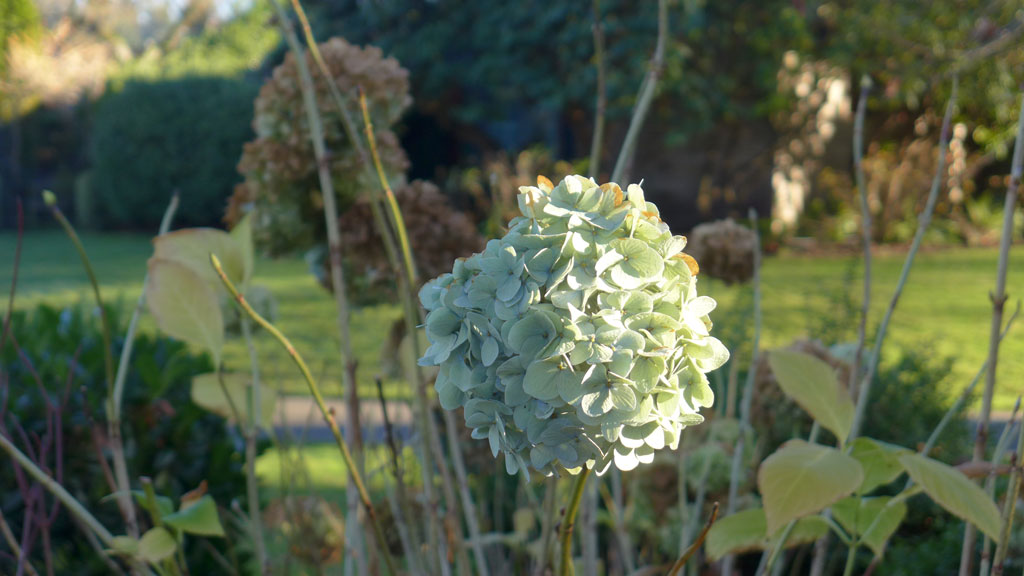
There are several categories of hydrangeas and knowing what type you have will help you choose the best pruning method for your plant and your goals. The major types of hydrangeas are:
Bigleaf hydrangeas/Hydrangea macrophyla (including the subcategories of mophead, lacecap, and mountain); Panicle hydrangeas/Hydrangea paniculata; Smooth hydrangeas/Hydrangea arborescens; Oakleaf hydrangeas/Hydrangea quercifolia and, Climbing hydrangeas/Hydrangea petiolaris.
There are also several pruning methods and picking a method should be based on your garden goals. Examples of pruning goals are: controlling size, renovating a shrub, deadheading, or tidying and shaping.
Generally, hydrangeas are tough and take pruning well, but know that some hydrangeas bloom on this year’s canes and some hydrangeas bloom on last year’s canes. Smooth hydrangeas/Hydrangea arborescens and Panicle hydrangeas/Hydrangea paniculata bloom on this year’s canes so you can cut them back to the ground and still get blooms the following season. Bigleaf hydrangeas/Hydrangea macrophyla, Oakleaf hydrangeas/Hydrangea quercifolia, and Climbing hydrangeas/Hydrangea petiolaris bloom on last year’s canes, so if you cut all the canes on these plants to the ground, you may have to wait a full season for flowers.

Wait to Deadhead Hydrangeas until February if Possible
Controlling Size and Renovating:
As mentioned above, some gardeners prune their hydrangeas hard to the ground (3-12” high) regularly. This is often done to keep a plant small, globe-shaped, and “in-bounds”. Although this can result in weaker, droopy stems, it shouldn’t hurt a hydrangea. Another way to attempt to control size is to prune out up to 1/3 of the tallest canes every year. Alternatively, and for a bushier look, you can grab a too-tall cane and snip it back to a node, a bud or a side branch. If you are spending a lot of energy/time controlling size, you may want to consider moving your hydrangea. Hydrangeas take well to transplanting when they are dormant (in the winter) but they will need plenty of water as they reestablish.
Deadheading:
Deadheading (cutting off the spent flowers) hydrangeas is not, strictly speaking, necessary but most people prefer to. When deadheading hydrangeas, leave the brown blooms on the plant throughout the fall and early winter. The blooms are said to protect the buds beneath them from cold weather and if you cut them too early, the plant will spend energy trying to heal the wound during a time when its trying to go to sleep. If you wait until late-winter/early-spring (around February) when the buds below the dead flower begin to swell, the flower tips should be fully dormant and ready for pruning. This is an ideal time to deadhead.
Tidying and Shaping:
If you do not need to keep the size of your plant in check, selective pruning will be less work and is likely to result in a healthier plant overall. You can use selective pruning to tidy a plant and/or shape it. Follow the “DDD” pruning rule first: remove dead, diseased, and damaged wood. Then, you can remove unwanted canes, which might include canes that are rubbing together or crossing, laying on the ground, too close to a structure, or too crowded together. Again, the canes can be cut all the way to the ground, or to a side branch, a node, or a bud.
NOTE: Pruning Panicle Hydrangeas/Hydrangea paniculata
Unless you are growing them for their tree or high shrub form, many people prune their Panicle Hydrangeas/Hydrangea paniculata back to the ground every year. Prune them in February to between three and twelve inches high. This will be a yearly task and since they bloom on new wood, this shouldn’t interfere with their flower production.



